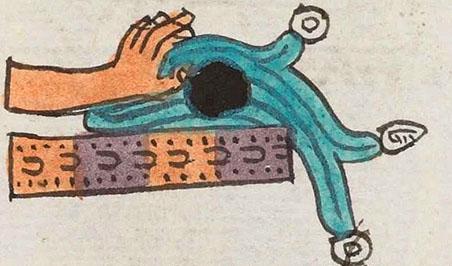Chietlan (Mdz42r)
This compound glyph for the place name Chietlan includes several elements. One is a left hand (with partial arm) reaching in from the left, seemingly grabbing water (atl). Near the hand is a large black dot or ball, in the midst of the water. Perhaps this is a black bean (etl)? Below these elements is a horizontal strip of land that has the iconography of cultivation. It looks much the same as tlalli, milli, and chinamitl. The hand is terracotta colored. The water is the usual turquoise blue with black lines showing flow or movement, and two white droplets/beads and a white turbinate shell coming off the flow. The agricultural parcel is segmented (into four segments of alternating purple and terracotta. These segments have dots and sideways u's. The -tlan locative is not visual, but it may be represented semantically by the landscape features of the compound.
Stephanie Wood
The root for this place name refers to the food called chia in both English and Spanish, and chian or chiyantli in Nahuatl. It can also be spelled chien or chiyentli. Chia seeds are often represented as black dots. In this place name, here, there is one large black dot, which is a little puzzling. But the large black dot could be meant to elicit the phonetic "e" of Chietlan. Berdan and Anawalt noticed the agricultural parcel and the water, and wondered if chinampas (chinamitl in Nahuatl) were coming into play. The root for chinamitl is chinan-, which is not a part of this place name. Also, the locative suffix (-tlan), while not represented visually as teeth, is attested in the gloss to have a final (-n). Thus, it is place, not place of abundance; the latter would be -tla (or -tlah, if we show a glottal stop). The final (-n) is missing in the modern rendition of the place name, but final n's can disappear over time.
Stephanie Wood
chietlan. puo
Chietlan, pueblo (Chietla, Puebla, today)
Stephanie Wood
c. 1541, but by 1553 at the latest
Stephanie Wood
hands, arms, water, shell, nombres de lugares

chia(n), chia seeds and oil, https://nahuatl.wired-humanities.org/content/chian
chiyan(tli), chia seeds and oil, https://nahuatl.wired-humanities.org/content/chiyantli
a(tl), water, https://nahuatl.wired-humanities.org/content/atl
e(tl), bean, https://nahuatl.wired-humanities.org/content/etl
-tlan (locative suffix, https://nahuatl.wired-humanities.org/content/tlan
ma(itl), hand or arm, https://nahuatl.wired-humanities.org/content/maitl
"Chia Place" (noting that the locative suffix is -tlan and not -tlah) [Frances Karttunen, unpublished manuscript, used here with her permission.]
"Where There Is Much Chia" or "Where There Are Many Chinampas" (Berdan and Anawalt, 1992, vol. 1, p. 177)
Codex Mendoza, folio 42 recto, https://digital.bodleian.ox.ac.uk/objects/2fea788e-2aa2-4f08-b6d9-648c00..., image 94 of 188.
The Bodleian Libraries, University of Oxford, hold the original manuscript, the MS. Arch. Selden. A. 1. This image is published here under the UK Creative Commons, “Attribution-NonCommercial-ShareAlike 3.0 License” (CC-BY-NC-SA 3.0).




